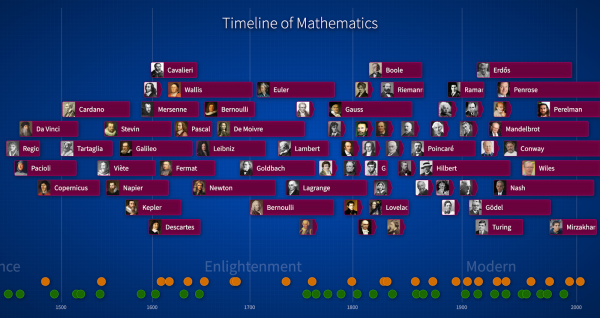This is a guest post from Philipp Legner, the creator of Mathigon – an interactive maths education platform.
Every year, thousands of students around the world ask themselves why they have to learn mathematics. Calculators can do long division. You can look up the quadratic formula on the internet. And when will you ever need calculus in everyday life? It seems like they have a point.
In fact, the maths curriculum has not changed significantly in the last 50 years. Its primary focus is on memorising rules and procedures which can be used to solve standardised exam questions. I created Mathigon because I strongly believe we need to change this – not only to make mathematics more enjoyable for students, but also to teach different skills that are much more useful in life: problem-solving, abstraction, logical reasoning, creativity, and curiosity.
Mathigon is a digital textbook for secondary mathematics. Some topics are still under development, but it’s completely free to use, and the code is published open-source on GitHub. The key idea is that the learning experience should be as “active” as possible, allowing students to engage, explore and discover (rather than simply “consume information”, for example by watching a video).
In education research, this approach is often called Constructionism, a team coined by Seymour Papert around 1980. Students are encouraged to create their own mental models, not just memorise what a teacher tells them. That’s why every Mathigon course is filled with interactive diagrams, simulations and games – here are a few examples:
Can you draw a path through this city, that crosses every bridge exactly once? This is known as the Königsberg Bridges Problem, and was solved 300 years ago by Leonard Euler.
Pascal’s triangle is created using a simple pattern: every cell is the sum of the two cells above. But watch what happens if you colour all cells that are divisible by a certain number:
The content is revealed in small steps, as you interact with it, allowing us to seamlessly personalise the experience for different students. And if you’re stuck, there is a virtual personal tutor who can give hints and answer questions.
Whenever I start writing a new course, the most important task is to find interesting stories to go along with the mathematical content. These could be real-life applications (like cryptography or weather prediction), entirely fictional (like the projectile motion of Angry Birds), or based on historical context. There even is a detailed timeline of mathematics including biographies of 100 mathematicians:

Storytelling makes the content much more fun and engaging for students. Rather than learning about abstract concepts and equations, there is a concrete reason why what they’re learning is useful and worthwhile. At the same time, stories make the content much more memorable.
I started Mathigon while volunteering with Stimulus, an outreach project at Cambridge University. Since then, the platform has grown significantly, and I hope that it can help get many more students excited about learning mathematics.
Going back to the very beginning of this article – why should students actually learn mathematics? Some basic topics are clearly useful in everyday life (e.g. simple arithmetic or interpreting statistical data). Many technical professions that drive our economy require maths, but more importantly, learning mathematics teaches important transferrable skills like problem-solving and logical thinking. Finally, mathematics can explain the laws of nature and is the foundation of almost every modern, technical innovation. Learning mathematics is learning about our culture – just like listening to Mozart or reading Shakespeare.
Explore Mathigon.org at your leisure.